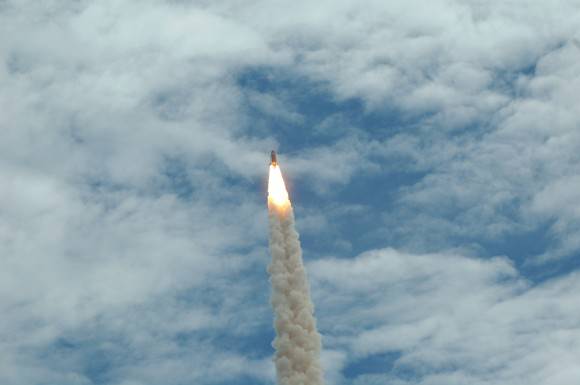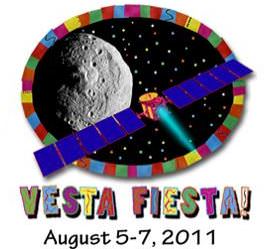Here’s a fantastic look at launch day for the Juno spacecraft, now on its way to Jupiter. It’s hard not to get pumped up for the mission after watching the Atlas V rocket blast into space, sending Juno on its journey. This video is courtesy the United Launch Alliance (ULA). Universe Today will have more original videos from launch day soon from our team of photographers and videographers who were on hand at Kennedy Space Center.
Juno Blasts off on Science Trek to Discover Jupiter’s Genesis
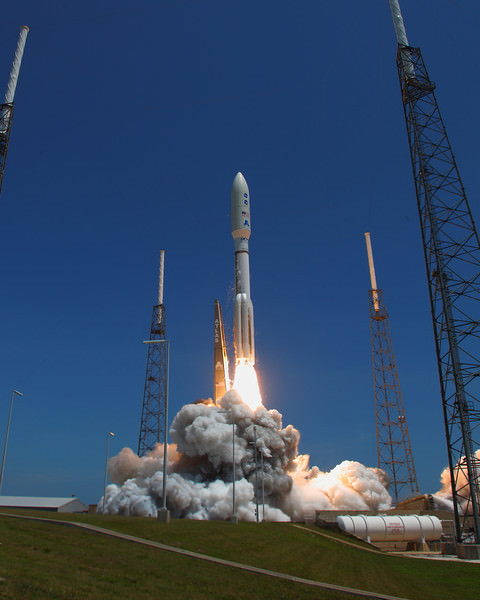
[/caption]
NASA’s solar powered Juno spacecraft blasted off today (Aug.5)from Cape Canaveral today to begin a 2.8 billion kilometer science trek to discover the genesis of Jupiter hidden deep inside the planet’s interior.
Upon arrival at Jupiter in July 2016, JUNO will fire its braking rockets and go into polar orbit and circle the planet 33 times over about one year. The goal is to find out more about the planets origins, interior structure and atmosphere, observe the aurora, map the intense magnetic field and investigate the existence of a solid planetary core.
The spacecraft is healthy and the solar panels successfully deployed.
Check out the photo album of Juno’s launch from the Universe Today team of Alan Walters and Ken Kremer.
“Jupiter is the Rosetta Stone of our solar system,” said Scott Bolton, Juno’s principal investigator from the Southwest Research Institute in San Antonio. “It is by far the oldest planet, contains more material than all the other planets, asteroids and comets combined and carries deep inside it the story of not only the solar system but of us. Juno is going there as our emissary — to interpret what Jupiter has to say.”
Juno was launched atop a powerful Atlas V rocket augmented by 5 solid rocket boosters – built by United Launch Alliance
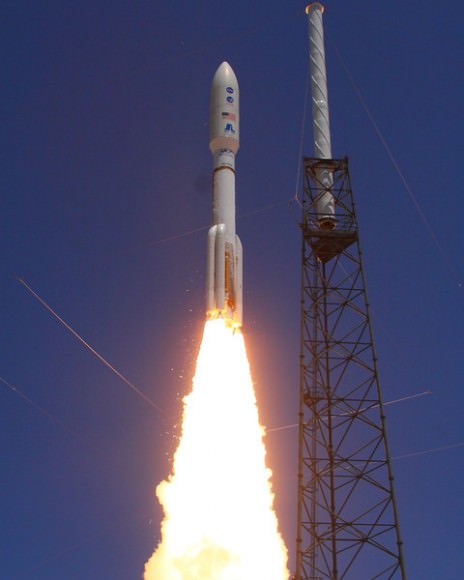
“Today, with the launch of the Juno spacecraft, NASA began a journey to yet another new frontier,” NASA Administrator Charles Bolden said. “The future of exploration includes cutting-edge science like this to help us better understand our solar system and an ever-increasing array of challenging destinations.”
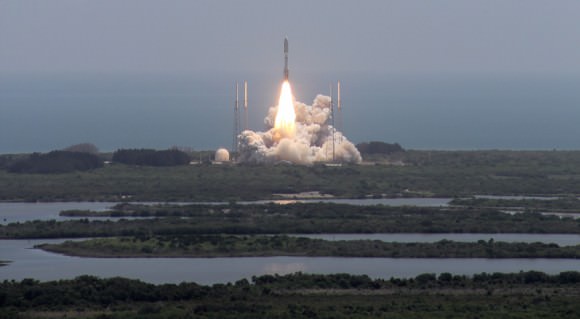
Atlas V liftoff with JUNO to Jupiter on Aug. 5 from Cape Canaveral Air Force Station. Credit: Ken Kremer
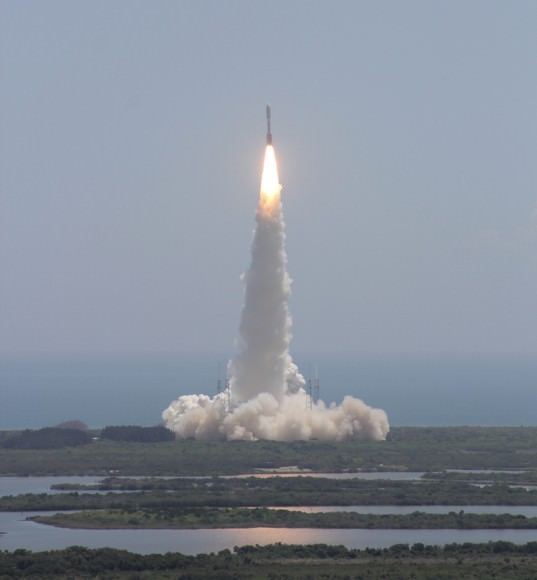
Atlas V liftoff with JUNO to Jupiter on Aug. 5 from Cape Canaveral Air Force Station. Credit: Ken Kremer (kenkremer.com)
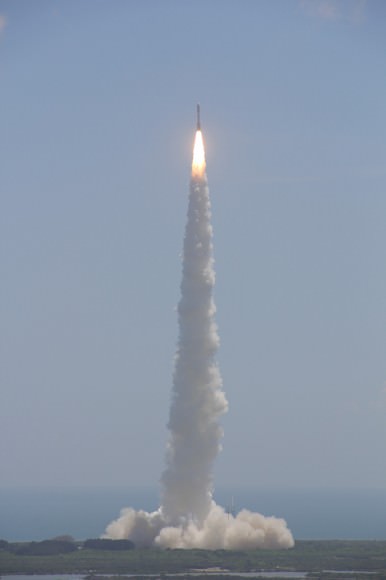
JUNO blasts off for Jupiter on Aug. 5 atop an Atlas V rocket from Cape Canaveral Air Force Station at 12:25 p.m. EDT.
Credit: Ken Kremer (kenkremer.com)
Send Ken your Juno launch photos to post at Universe Today
Read my continuing features about Juno
Juno Jupiter Orbiter poised at Launch Pad for Aug. 5 Blastoff
JUNO Orbiter Mated to Mightiest Atlas rocket for Aug. 5 Blastoff to Jupiter
Solar Powered Jupiter bound JUNO lands at Kennedy Space Center
Watch Juno Launch Live!
Live video for mobile from Ustream
NASA’s new science probe to Jupiter, Juno, will make its first launch attempt on Friday, Aug. 5 at 15:34 UT (11:34 a.m. EDT) from Cape Canaveral Air Force Station in Florida. Watch it live on NASA TV’s UStream channel.
New Evidence for Flowing Water on Mars
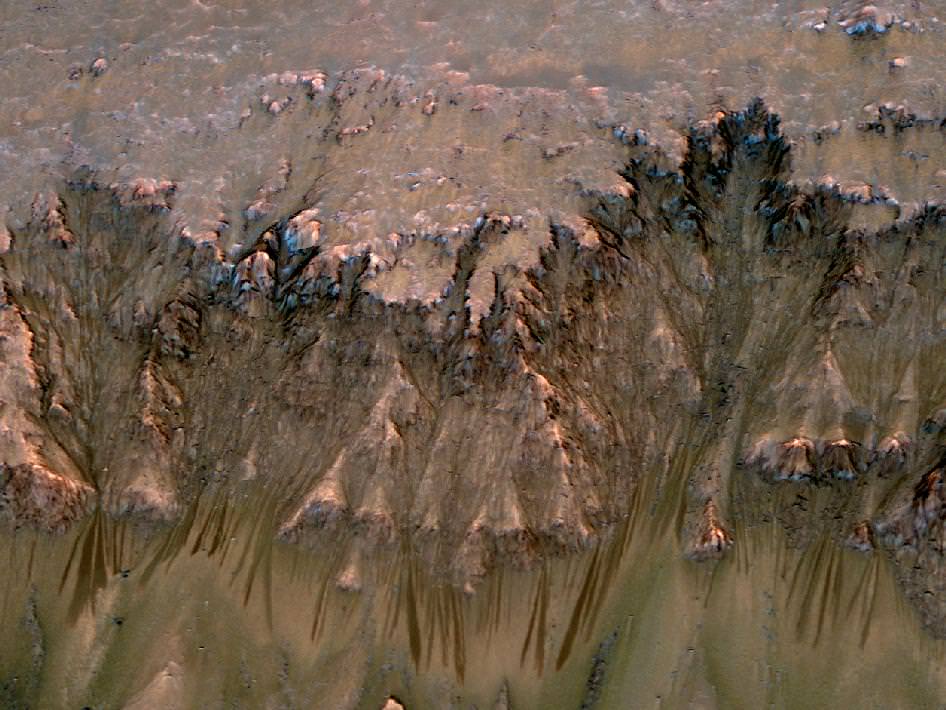
[/caption]
In a news conference today, NASA announced discoveries that provide additional evidence of seasonal water flows on Mars. Using data collected by the Mars Reconnaissance Orbiter, the MRO team presented images of dark lines that form on slopes during the martian spring/summer and fade in winter.
During the news conference, HIRISE principal investigator Alfred McEwen (University of Arizona), discussed that these “finger-like” features were found in Mars’ mid-southern latitudes. “The best explanation for these observations so far is the flow of briny water,” he said.
McEwen based his explanation on several key facts: First, salt lowers the freezing point of water (“plain” water would simply stay frozen on Mars) Secondly, the temperature on Mars during these flows ranges from -23 to +27 degrees Celsius, which rules out CO2. While there is significant evidence of flowing water, the team did state that there is no direct detection of water since it evaporates quickly on Mars.
Regarding the dark color of the flows, McEwen added, “The flows are not dark because of being wet, they are dark for some other reason.” McEwen also mentioned that researchers will need to re-create Mars-like conditions in the lab to better understand these flows, stating, “It’s a mystery now, but I think it’s a solvable mystery with further observations and laboratory experiments.”
MRO Project Scientist Richard Zurek (JPL) offered his thoughts as well. “These dark lineations are different from other types of features on Martian slopes,” he said, “and repeated observations show they extend ever farther downhill with time during the warm season.”

What also proves intriguing to the team is that while gullies are very abundant on colder slopes that face the poles, the dark flows discussed in today’s news conference are found on warmer slopes which face the equator.
During the conference, Philip Christensen (Arizona State University) presented a map showing concentrations of “salts” in the same locations that the dark, “finger-like” flows were found.
McEwen reiterated during the Q&A session that the Compact Reconnaissance Imaging Spectrometer for Mars (CRISM), hasn’t detected any signs of water and that laboratory simulations will be necessary to gain a better understanding of these features – basically the team is seeing signs of flowing water, but not the water itself.
If you’d like to learn more about the Mars Reconnaissance Orbiter and today’s announcement, you can visit: http://www.nasa.gov/mro
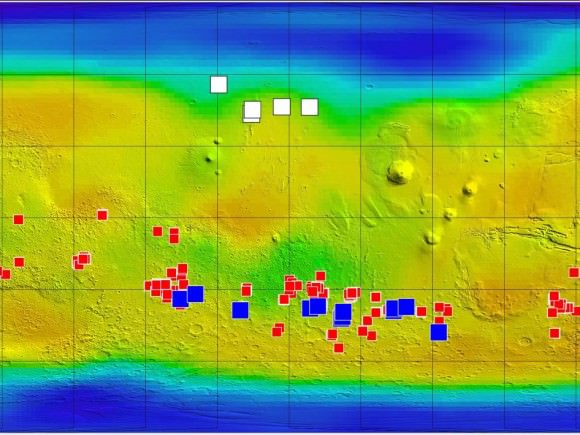
To see more images related to the new findings, see this link from JPL.
Sources: NASA/JPL News Conference, NASA/JPL News
Have a Vesta Fiesta This Weekend!
To help celebrate the start of the Dawn mission to Vesta, NASA is organizing a “Vesta Fiesta!” After traveling the solar system for nearly four years, the Dawn spacecraft is now entering the “science” phase of its mission. Given the fact that Dawn is the first spacecraft to orbit an object in the asteroid belt, a fiesta is in order! (Here in Arizona we relish ANY excuse to fiesta!) Between August 5 and August 7, 2011, Vesta Fiestas will be held to help celebrate Dawn’s arrival at Vesta.
NASA is encouraging fans of the Dawn mission to join the celebration by hosting events at local clubs, schools, museums or societies. NASA has also provided numerous resources that are free to use for Vesta Fiestas, including games and activities, media resources (invitations, audio files, observing info, etc.) and live video on August 6th from the “Flagship” celebration at JPL in Pasedena, California.
If you’d like to participate by hosting your own party, or to find a party in your area, visit this page on the Dawn website, or on Facebook at: http://www.facebook.com/event.php?eid=225252850843508
You can also follow the Dawn mission on Twitter
After studying the asteroid Vesta, Dawn will continue on to study dwarf planet Ceres, also in the main asteroid belt between Mars and Jupiter.
To help encourage participation, I humbly offer my Spicy Fiesta Cheese Dip:
Ingredients:
1lb sausage (breakfast or Italian)
1 block of Velveeta (cut into ~1 inch square cubes)
1 jar of your favorite salsa and (Optional) 1 small can (4oz?) of diced green chile peppers – Not Red Hot Chili Peppers! Flea, Chad and Anthony hate being diced.)
Procedure: Place 1/2 of the cubed Velveeta in a crock pot, set to “high”. Cook sausage and diced peppers completely in a skillet, add cooked sausage and peppers to the crock pot along with the salsa and remaining velveeta. Leave crock pot on “high” until all the Velveeta is melted, then set to “low” – stir often! Serve with tortilla chips and an ice cold drink of your choice.
If you’d like to learn more about the Dawn mission to Vesta and Ceres, you can visit the Dawn website.
Chasing Rockets, Chasing History: One Journalist’s Video Reflections
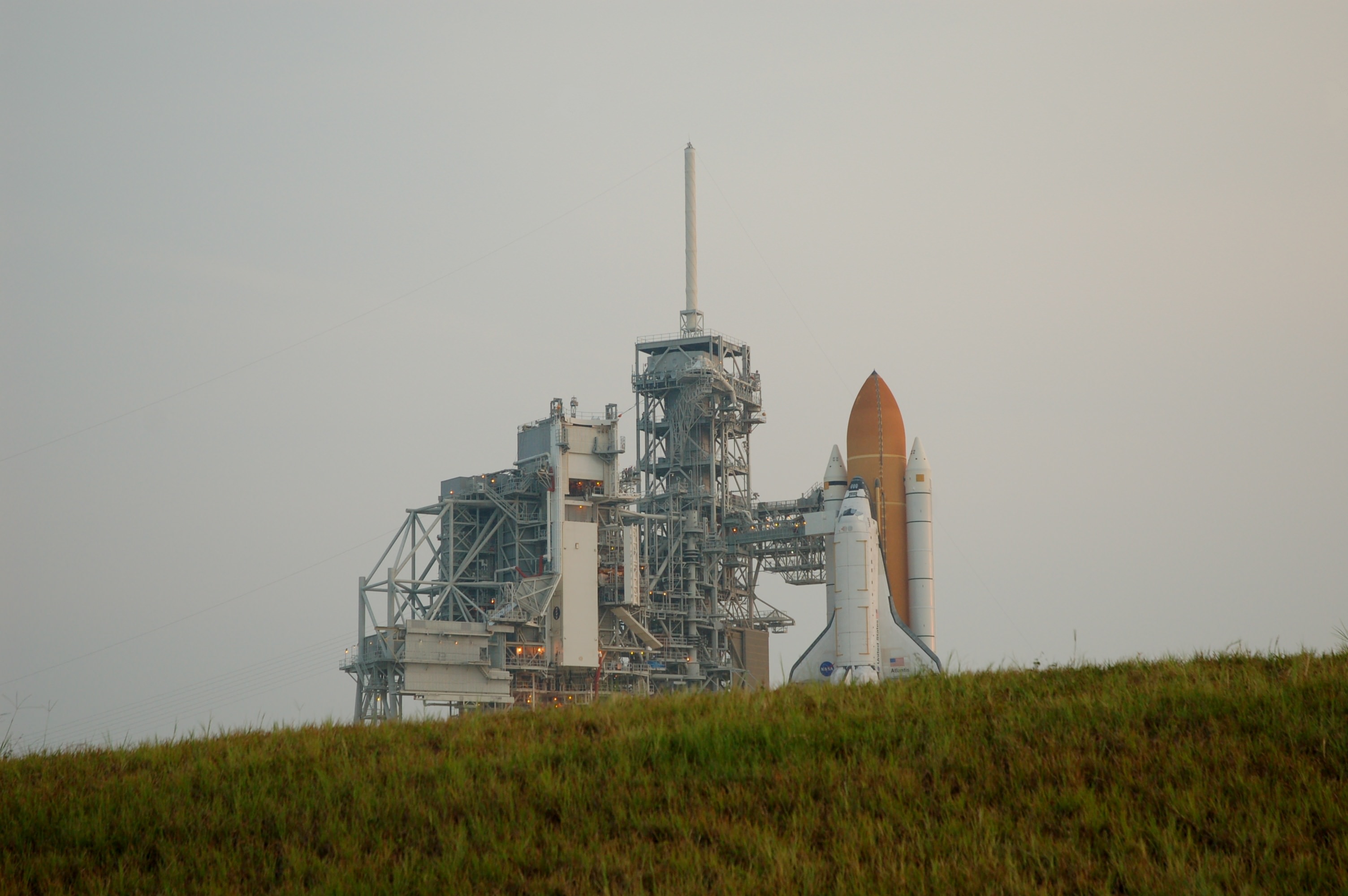
[/caption]
CAPE CANAVERAL Fla. – As one might imagine covering the space program is a exciting vocation. Some professionals focus on writing articles or taking pictures others work with television stations or online media outlets to provide video and commentary. I have selected to attempt to do all of the above. This can be rather challenging. During the final launch of Atlantis for example, I conducted interviews with a variety of guests up until the launch, from there I operated two camcorders and a DSLR camera (for stills).
Doing things this way provides outlets with a wealth of different types of content to choose from. This also means that a lot of material is not used. This article will cover some of the things that ended up on the cutting room floor. What was not used – might surprise you.
SpaceX Surprises
Of the NewSpace organizations that have made their presence known out at Kennedy Space Center – Space Exploration Technologies or SpaceX has had the most significant impact. Lately the firm has worked to get the media out, as much as possible, to see what the company is doing. NASA and many of the established aerospace companies have a hands off approach – essentially you report on what they allow you to report. SpaceX? They allowed this reporter to climb underneath the Falcon 9 and even have it spun on command. Check it out:
Shuttle Memories
Trying to accurately record and report the historic nature of what took place at Kennedy Space Center this summer was challenging. I took every opportunity I could to record what was happening and then relay that to the public. What I will always remember from this time was how open the members of NASA were and how they really tried to work with you to get the story out. To get a taste of what it was like, check out this compilation of shuttle videos from STS-133 through STS-135:
Launches
Whilst following the shuttle, the last two years have been punctuated by a number of awesome unmanned flights as well (not including the launch of the Falcon 9 which you can see above). The second OTV space plane, SBIRS, AEHF-1 and an impressive night launch of a Delta IV Heavy all helped to keep me on the road to Cape Canaveral:
Memorable Interviews
I’ve been privileged to interview many important people within the space community. That however does not mean that their interviews will stick out in my mind. Some of the ones that I remember best are from people that have always been a joy to work with. Stephanie Stilson is one of those people, she always has a kind word and a great quote. Greg Johnson is another, bombastic and easy-going, he has no problem whatsoever veering off of the official NASA script. To separate the two interviews I included a clip of the media being escorted up onto LC39A. Click below to watch:
Experiencing History
It is not every day that one gets to train along with the astronauts. I had the opportunity to do so on STS-135. I flew in the back of the Shuttle Training Aircraft (STA) as Commander Chris Ferguson practiced landing the shuttle. To date, this has to be the high point of my career:
Over the last two years I have been bombarded by folks stating that I should report things “their” way. Some want me to go hyper-technical, so that only an engineer could understand what I was saying. While I’m sure some folks wouldn’t mind breaking out a flight manual to keep up with the jargon – that really isn’t what I’m trying to accomplish. Others tell me to keep it as simple as possible and to never state anything that could be construed as negative – but that doesn’t reflect reality. I try to come in somewhere in the middle. The public should know that this is a highly technical endeavor – but they should also know that it is exciting, that this tale is not one without issues and that I try to show it all, the good, the bad and the awesome.
30-Year-Old 3-D Movie Made from Viking Data Gets New Life
Back in 1979, scientists at Stanford University created a 3-D movie from images sent back by the Viking landers on Mars. It was rather novel in that, while 3-D movies had been around since the 1950’s — mostly for low-budget B movies in theaters — this stereographic film was more scientific in nature, but was created for the public to learn more about the Viking mission and Mars, providing a “you are there” experience. It was created using 16mm film, which degrades over time. Considering the unique historical and scientific value of this film, a group from NASA’s Ames Research Center have constructed a new remastered digital version, made from the original 16mm film footage, sound reels, and related documentation.
Plans are underway to hold screenings of this new version of Mars in 3-D in Digital Cinema 3-D format. But in the meantime you can watch it now online in a digital anaglyph version, best viewed with red-cyan 3-D glasses.
Read more about the remastering process and read original papers from the imaging team from Viking at the Ames History Office website.
SDO Finds the Man in the Sun
We all know about the Man in the Moon, but the Solar Dynamics Observatory spacecraft has now detected an old man in the Sun, too. He was there, at least back on Dec. 9, 2010 when these images were taken, but has since disappeared. In different wavelengths, at times he appears happy, mischievous or even downright angry.
The movie underscores the fact that images taken at different wavelengths do reveal different features. The different wavelengths are shown in order from the lowest temperature material being imaged to the highest. The images also start at the Sun’s surface and gradually move out to the Sun’s upper corona.
SDO never fails to inform as well as amuse!
Kennedy Space Center Visitor Complex Marks 40th Anniversary of Apollo 15

[/caption]
CAPE CANAVERAL Fla. – Apollo 15 was the first manned lunar mission to use a lunar rover, the first of the “J” missions that would stay on the lunar surface longer and be focused on conducting science. Apollo 15 marked its 40th anniversary on Sunday. Most of the crew as well as other Apollo-era astronauts were present at the Kennedy Space Center Visitor Complex to mark the occasion.
The day’s events include a tour of the launch site at the adjacent Cape Canaveral Air Force Station. Shortly after returning to the Visitor Complex a panel discussion was held with Apollo 15 astronauts Dave Scott and Al Worden. The “moderator” for the event was none other than Apollo 12 Command Module Pilot Dick Gordon.
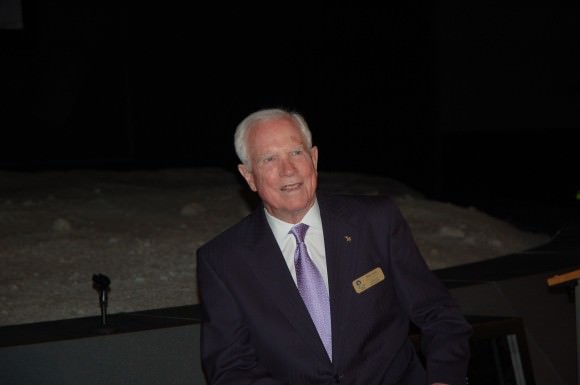
One thing that became quickly obvious was that the trio had done this before and were very comfortable with one another, clowning around, giving each other a hard time and telling jokes. Meanwhile, Gordon asked the two surviving Apollo 15 astronauts (the third member of the crew, James Irwin passed away in 1991) questions regarding the mission. This made learning about the importance of the mission both informative and fun. Panel discussions can be rather dry affairs – this one was lively and entertaining.
“I’ve lost control…” bemoaned Gordon as Scott and Worden talked about the mission to one another and the assembled guests.
At one point Worden was asked what the mission in general and his extra vehicular activity (EVA) was like.
“You know it’s like learning to play the piano, you practice and practice and practice and practice all week long and on Saturday you might give a recital,” Worden said. “But when the recital happens you don’t think about it – you just do it, there’s really not an emotional component to that.”
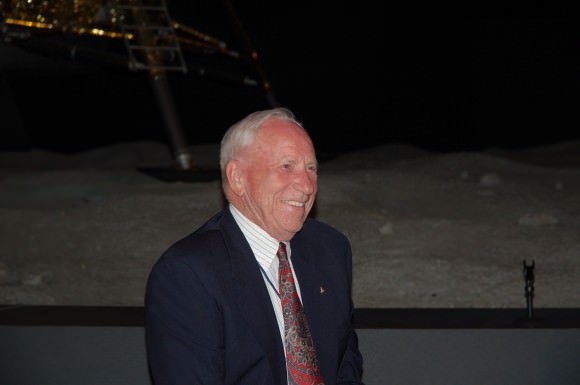
The operators of the Kennedy Space Center Visitor Complex spared little expense in ensuring that guests had a full and exciting day. The tour drove past several launch complexes including Launch Complex 34 (where the Apollo 1 fire occurred) as well as Launch Complex 39A, where the final shuttle mission launched from not too long ago. Each of the buses had the normal guide from the Visitor Complex as well as an Apollo-era astronaut, who regaled guests with various aspects of past missions. Guests also received a gift bag with several items enclosed to commemorate the occasion.
Apollo 15 launched on July 26, 1971 and ended with the splash down of the crew on Aug. 7, 1971. Scott and Irwin spent a total of three days on the moon with a little over 18 hours of that time spent on extra vehicular activity (EVA). Apollo 15 was also the first mission to not land on a lunar mare, but rather it landed near Hadley Rille, which is located around the area called Palus Putredinus (Marsh of Decay).
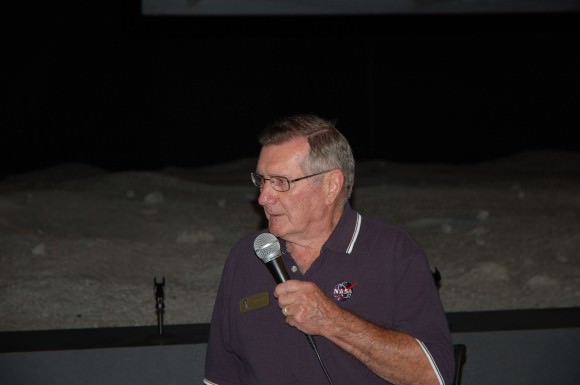
Having the lunar rover on this mission gave the moonwalkers the ability to traverse a far greater distance than what was possible on prior Apollo flights. While on the moon the duo collected about 170 lbs of rocks and lunar regolith. While Scott and Irwin were on the moon, Worden, circling high above in the Command Module compiled a highly detailed map of the lunar surface. A satellite was also deployed into lunar orbit on this mission (an Apollo first).
The day’s tour and panel discussion were capped off by a gala hosted by the Astronaut Scholarship Foundation. Those in attendance included Neil Armstrong as well as former Senator (New Mexico) and the first geologist to go to the moon Harrison ‘Jack’ Schmitt. Numerous other luminaries in the space field were present as well.
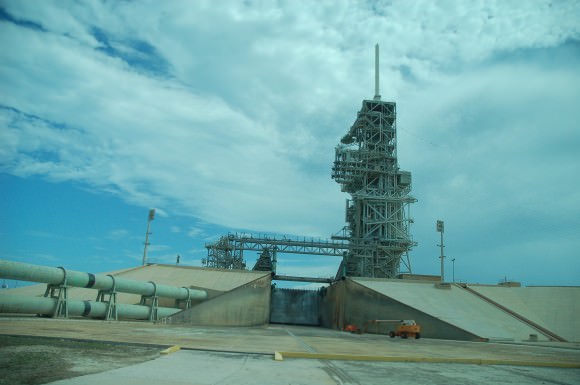
One On One With Space Shuttle Program’s First Pilot, Robert Crippen

[/caption]
CAPE CANAVERAL Fla. – The shuttle program has drawn to a close. Present at the final flight was one of the two men who rode fire on the very first shuttle mission – Robert Crippen. He sat down and shared his thoughts and perspectives with Universe Today regarding this turning point in aerospace history.
Crippen’s space flight career began alongside moonwalker John Young, who served as commander of STS-1. The orbiter for that flight was Columbia and the mission lasted about two days. Despite the mission’s brief time on-orbit it has come to be known as one of the most audacious test flights in aviation history.
Crippen would go on to fly three more missions on board the shuttle on missions STS-7, STS-41C and STS-41G. He would eventually become the Kennedy Space Center Director from 1992 until 1995 before working in the private sector.
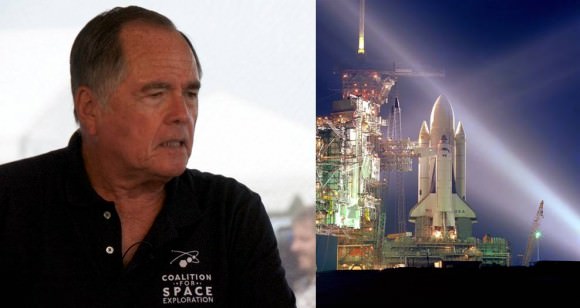
Universe Today: Thanks for talking with us today.
Crippen: Thanks for having me.
Universe Today: How do you think people will view the legacy of the shuttle program?
Crippen: “You never really know what history is going to say, but when I look back I’m really proud of the shuttle, its done revolutionary things, not just satellites, and the Hubble Space Telescope, but also the International Space Station, just accomplishment after accomplishment – but we had our share of tragedies as well. When I think of what people will think I always go back to a ‘Brooks and Dunn’ song – ‘You’re going to miss me when I am gone.”
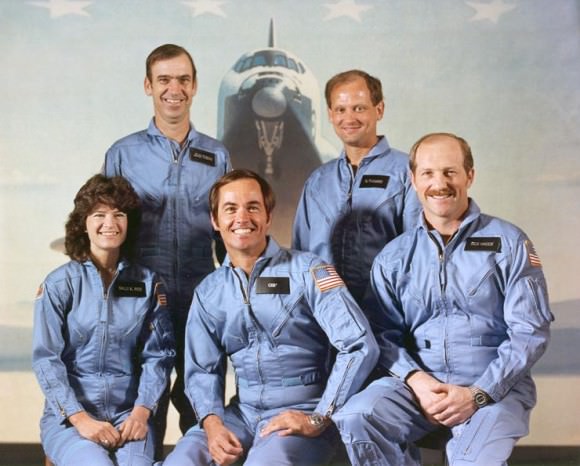
Universe Today: The shuttle that is launching today, is it all that different from what you flew on STS-1?
Crippen: “Airline pilots used to come up and tell us that their planes were better than the shuttle,” Crippen said. “You have to understand why they were saying that, when the shuttle first flew the gauges had little metal arms in them and the shuttle was still using cathode ray tubes – so yes, it is very different from I first flew on in 1981.”
Universe Today: What was it like on that first mission? Did you think with all the new technology and this completely new way of launching to orbit that you were going to go when you did?
Crippen: “I honestly didn’t think we were even going to launch when we did. But when those solids lit I had no doubt in my mind that we were going someplace! The best part was that John’s blood pressure stayed really low, like at around 90 and mine was really high, it was up around 130. All John had to say was that he was too old and his blood pressure wouldn’t go any faster.”
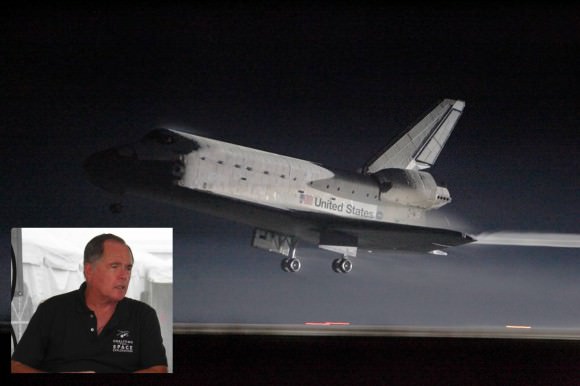
Universe Today: Bob you work with the Coalition for Space Exploration (CSE) this organization has put out a couple of well-produced Public Service Announcements lately, what are they about and why are they being released now?
Crippen: “Well, these PSAs try to focus on what I call the ‘spin-offs’ of the space shuttle program. The program has helped to produce or improve everything from heart pumps, how to rescue people out of vehicles after accidents and those types of things which, while important, one of the really important things that the space program does – is inspire.”
Universe Today: Thanks for taking the time to speak with us today, we know that you have a pretty tight schedule.
Crippen: No problem, it was my pleasure.
Crippen was kept very busy on launch day and soon he was off to another interview. As he headed out he turned and stated that he was proud that part of STS-1 (one of the Solid Rocket Booster segments) was flying on this final shuttle mission, he also made a prophetic comment concerning the weather. “You never know how the Florida weather is going to work, but I have a good feeling about today.” Less than an hour later, the final space shuttle mission thundered off of the launch pad – and into history.
